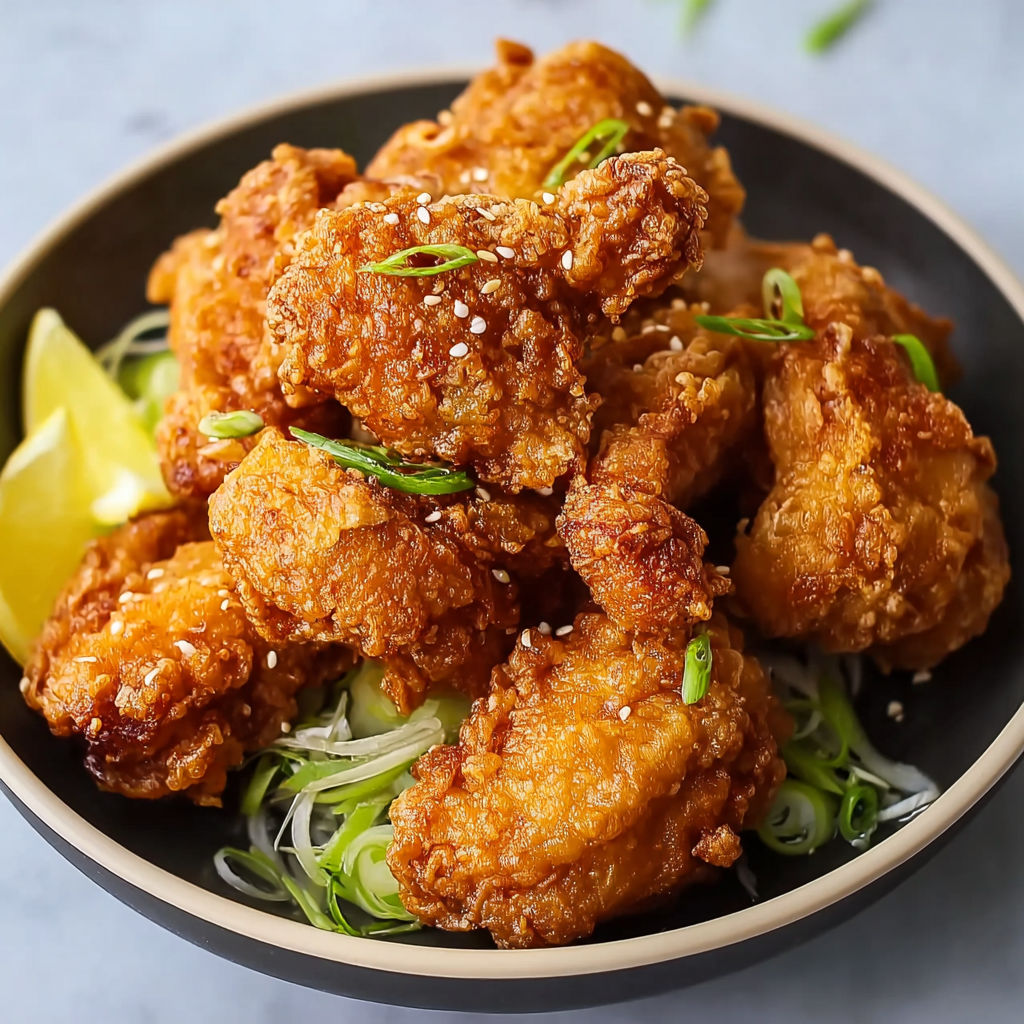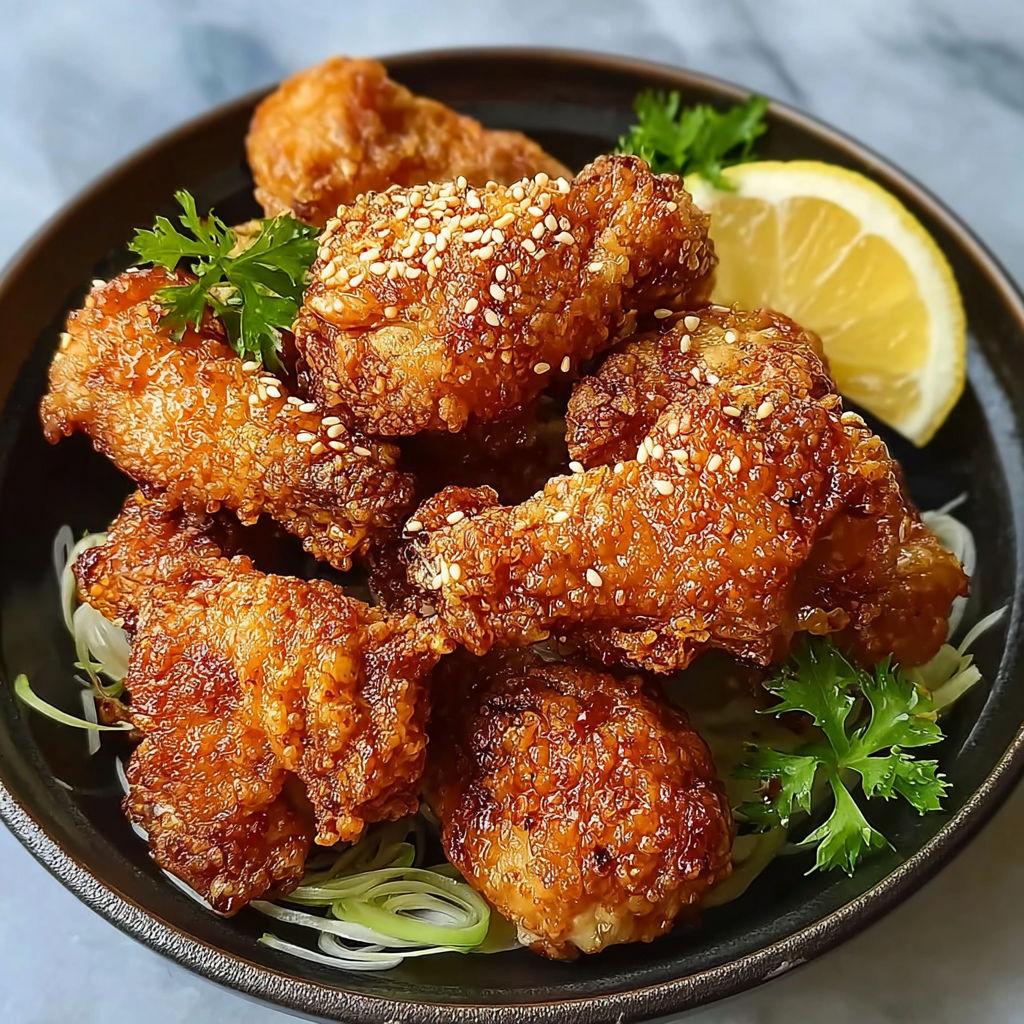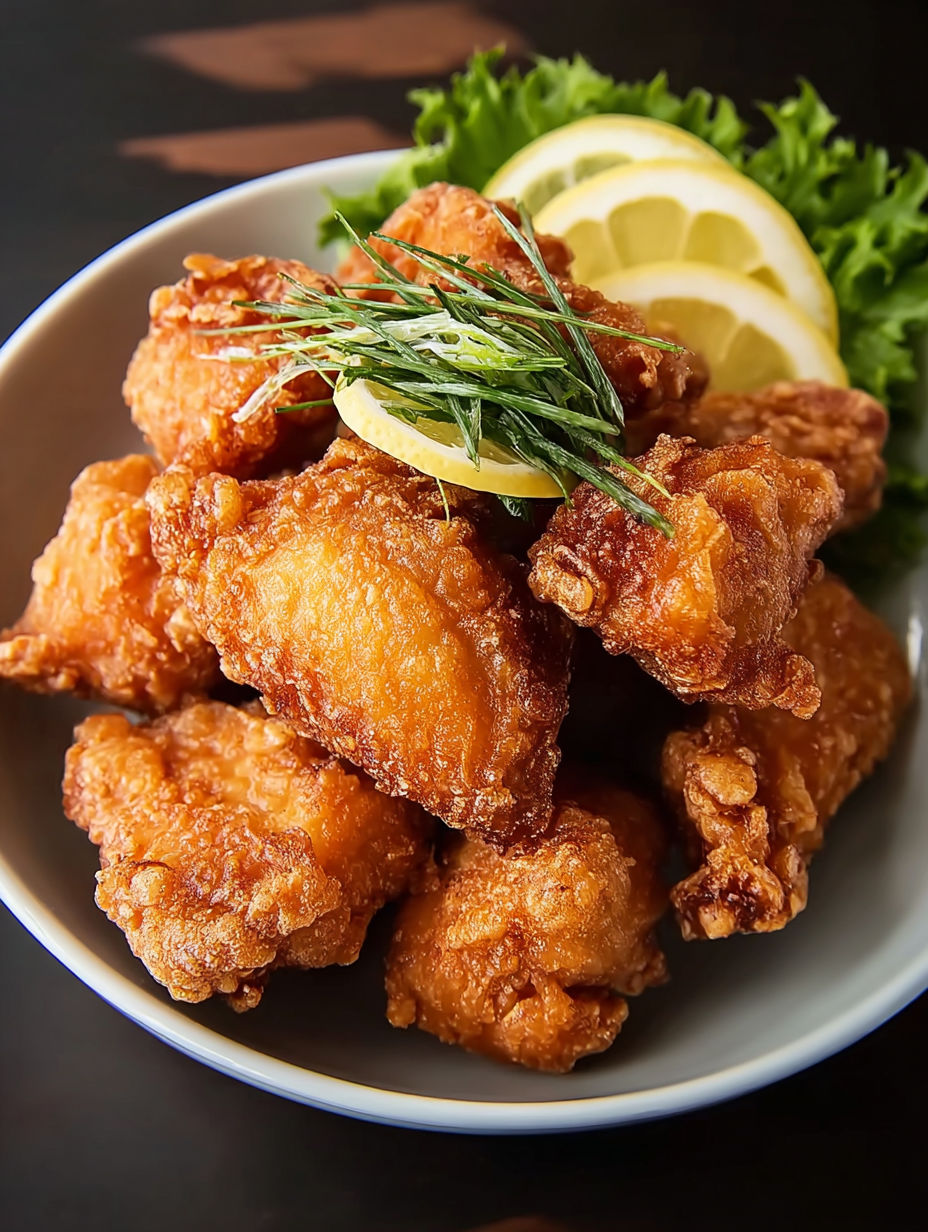 Pin it
Pin it
This crunchy Japanese chicken has completely transformed how I handle dinner on busy weeknights. With its crispy exterior and tender, juicy meat on the inside, karaage delivers authentic pub-style Japanese flavors in your own kitchen without much work.
The first time I cooked this karaage was for my mother-in-law who always says she hates fried stuff. Before we'd even finished eating, she wanted to know how I made it and now whips it up regularly for her card-playing friends.
- Chicken thighs without bones or skin. You really need dark meat here since it doesn't dry out when fried and tastes much better than breast meat
- Soy sauce gives that mouth-watering savory taste that makes you can't stop eating karaage
- Sake this Japanese wine softens the meat and adds nice background flavors
- Grated ginger don't even think about using dried - fresh ginger puts warm aromatic flavor into every bite
- Garlic finely chopped adds rich flavor that works really well with the ginger
- Sesame oil just a small amount brings a lovely nutty taste to the mix
- Potato starch this is why your chicken stays crunchy longer than if you used only regular flour
- All purpose flour combined with potato starch makes the perfect outer texture
- Vegetable oil pick one without strong flavor that can handle high heat for clean frying
- Lemon wedges their tang cuts through the richness perfectly
- Japanese mayo you don't have to use it, but it really completes the authentic experience
Incredible Japanese Fried Chicken (Karaage)
- Mix your flavoring liquid
- In a bowl of medium size, stir together soy sauce, sake, fresh ginger you've grated, chopped garlic, and a bit of sesame oil. Mix everything until it's completely blended. This fragrant mix is what gives karaage its special taste.
- Soak the chicken
- Cut your thighs into chunks about 2 inches big and toss them into the mixture. Get your hands in there and rub the liquid all over each piece to make sure they're fully coated. Cover the bowl with some plastic and let it sit in the fridge for at least half an hour, but two hours will give you much better flavor.
- Get your coating ready
- While your chicken is soaking up flavors, mix your potato starch and regular flour in a flat dish. These two together make the perfect balance of crunch and sticking power. Some places in Japan only use potato starch, but I think this combo works better when you're cooking at home.
- Get your oil hot
- Fill a heavy pot or deep pan with vegetable oil about 2 inches deep. Warm it up to 170°C exactly. If it gets too hot, the outside will burn while the inside stays raw. Too cool and your chicken soaks up too much oil and gets soggy.
- Do your first fry
- Work with small groups of 5-6 pieces, taking them out of the marinade and letting extra liquid drip off. Roll each piece in the flour mix, pressing gently so it sticks well. Carefully drop them into the hot oil and cook about 90 seconds until they look pale gold. Put them on a wire rack. This first cooking gets the inside done.
- Let them rest
- Give your first batch about 4 minutes to sit. This break is super important because it lets the moisture inside spread out, making steam that slightly pulls the coating away from the meat, which gives you that airy crunch.
- Fry them again
- Put the chicken back in the oil, now hotter at 180°C, for just 1-2 minutes until they turn a rich golden color and get super crunchy. This twice-fried method is what makes truly great karaage. The outside gets that amazing crackly texture while the inside stays juicy.
- Eat right away
- Place them on some paper towels to soak up extra oil, then put them on a nice plate with lemon pieces. Enjoy with Japanese mayo or any dip you like while they're still hot and extra crunchy.
The ginger in this dish really changes everything. One time I accidentally put in twice as much as I meant to and found out it made everything smell and taste even better - now my family won't let me make it any other way. Last year my daughter asked for this karaage instead of going to her favorite restaurant for her birthday dinner.
 Pin it
Pin it
The Key To Amazing Flavor Soaking
Great karaage starts with letting the meat soak up flavors properly. While 30 minutes works when you're in a hurry, letting your chicken sit in the marinade overnight makes a huge difference. The sake starts breaking down the meat proteins while the soy sauce goes deeper into each piece. When I'm having family over, I get the chicken soaking the night before and everyone notices how much better it tastes when I plan ahead.
Turn It Into A Full Dinner
Karaage works best as part of a simple Japanese home dinner. Serve it with fluffy short grain rice, some miso soup, and sliced cucumbers tossed with rice vinegar and sesame seeds. For a pub-style meal at home, grab some cold beer or chilled sake and add some steamed edamame beans and pickled veggies on the side. My family loves putting karaage on top of rice with some green onions sprinkled on and a little spicy mayo drizzled over everything.
Keeping And Warming Up Leftovers
Karaage tastes best right after cooking, but you can keep leftovers in a sealed container in the fridge for up to 3 days. Don't use the microwave to warm it up or it'll get soft and soggy. Instead, put it in a 350°F oven for 7-10 minutes until it's hot and crispy again. If you want to prep ahead, you can marinate and coat the chicken, then freeze it raw on a baking sheet before putting pieces in freezer bags. When you're ready, cook the frozen chicken directly in the oil, just add about 2 minutes to your cooking time.
Different Ways It's Made
Karaage isn't made the same way across Japan. In Oita, folks often add extra garlic to the marinade and serve it with a light fish broth-soy sauce mix. Nakatsu style uses bigger chunks of chicken while Tatsuno adds local citrus fruits. My version comes mostly from Tokyo-style karaage but with sesame oil added - something I learned during a cooking class I took in Kyoto. The teacher told us that every family puts their own little twist on this favorite dish.
 Pin it
Pin it
Frequently Asked Questions
- → What makes Karaage different from typical fried chicken?
Compared to Western fried chicken, karaage uses boneless thighs instead of bone-in cuts, has a soy-based marinade rather than buttermilk, and gets its crispiness from potato starch instead of breadcrumbs. The result? A lighter crunch with great umami flavor.
- → Can chicken breast work for Karaage?
Sure, chicken breast's an option, but thighs are juicier. Cut breast meat into slightly bigger chunks, fry for less time (shave off about 30 seconds), and let it marinate a tad longer for better tenderness.
- → What if I don’t have sake for the marinade?
No sake? No problem! Dry sherry or Shaoxing wine are great stand-ins. If you need alcohol-free options, mix chicken broth and rice vinegar, or try apple juice with a splash of vinegar for a similar flavor punch.
- → Tips for making the crispiest Karaage?
If you’re after unbeatable crispiness, double-frying’s your friend. Fry once at 320°F (160°C) for just over a minute, let the chicken rest briefly, then fry again at 350°F (175°C) until golden. Also, keep the starch coating light and don't overcrowd the pan.
- → What are some classic side dishes for Karaage?
Typical sides include shredded cabbage, rice, miso soup, and pickles (tsukemono). Lemon wedges and creamy Japanese mayo (Kewpie) are spot-on condiments. Cold beer or sake make it feel like an Izakaya meal!
- → How long should the chicken marinate?
A good rule of thumb is 30 minutes to 4 hours. Overnight works too, but it can alter the chicken’s texture if left too long because of the acid. A 2-hour soak gives tasty, tender results without being over-marinated.
